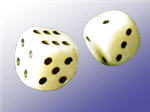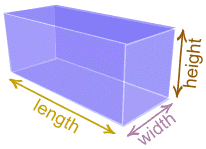Circle Equations
 |
A circle is easy to make:
Draw a curve that is "radius" away
from a central point.
And so:
All points are the same distance
from the center.
|
In fact the definition of a circle is
Let us put that center at (a,b).
So the circle is all the points (x,y) that are "r" away from the center(a,b).
| 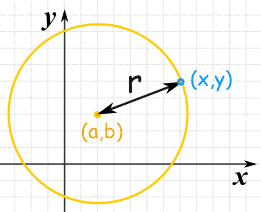 |
Now we can work out exactly where all those points are!
We simply make a right-angled triangle (as shown), and then use Pythagoras (a 2 + b 2 = c 2):
And that is the "Standard Form" for the equation of a circle!
| 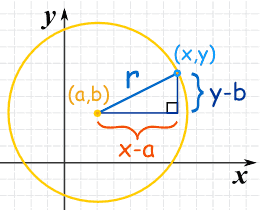 |
You can see all the important information at a glance: the center (a,b) and the radius r.
General Form
But you may see a circle equation and not know it!
Because it may not be in the neat "Standard Form" above.
As an example, let us put some values to a, b and r and then expand it
| Start with: | | (x-a)2 + (y-b)2 = r2 |
| | | |
| Set (for example) a=1, b=2, c=3: | | (x-1)2 + (y-2)2 = 32 |
| | | |
| Expand: | | x2 - 2x + 1 + y2 - 4y + 4 = 9 |
| | | |
| Gather like terms: | | x2 + y2 - 2x - 4y + 1 + 4 - 9 = 0 |
And we end up with this:
x2 + y2 - 2x - 4y - 4 = 0
It is a circle equation, but "in disguise"!
So when you see something like that think "hmm ... that might be a circle!"
In fact we can write it in "General Form" by putting constants instead of the numbers:
x2 + y2 + Ax + By + C = 0
Going From General Form to Standard Form
Imagine you have an equation in General Form (like the example above):
x2 + y2 - 2x - 4y - 4 = 0
How could you get it into Standard Form like (x-a)2 + (y-b)2 = r2 ?
| Start with: | | x2 + y2 - 2x - 4y - 4 = 0 |
| | | |
Put xs and ys
together on left: | | (x2 - 2x) + (y2 - 4y) = 4 |
Now to complete the square you take half of the middle number, square it and add it.
(Also add it to the right hand side so the equation stays in balance!)
And do it for x and y.
|
| Do it for "x": | | (x2 - 2x + (-1)2) + (y2 - 4y) = 4 + (-1)2 |
| And for "y": | | (x2 - 2x + (-1)2) + (y2 - 4y + (-2)2) = 4 + (-1)2 + (-2)2 |
| | | |
| Simplify: | | (x2 - 2x + 1) + (y2 - 4y + 4) = 9 |
| Finally: | | (x - 1)2 + (y - 2)2 = 32 |
And we have it in Standard Form!
Unit Circle
If we place the circle center at (0,0) and set the radius to 1 we get:
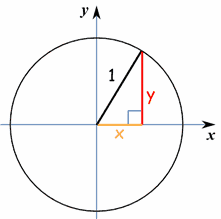 |
(x-a)2 + (y-b)2 = r2
(x-0)2 + (y-0)2 = 12
x2 + y2 = 1
Which is the equation of the Unit Circle |
How to Plot a Circle by Hand
1. Plot the center (a,b)
2. Plot 4 points "radius" away from the center in the up, down, left and right direction
3. Sketch it in!
Example: Plot (x-4)2 + (y-2)2 = 25
The formula for a circle is (x-a)2 + (y-b)2 = r2
So the center is at (4,2)
And r2 is 25, so the radius is √25 = 5
So we can plot:
- The Center: (4,2)
- Up: (4,2+5) = (4,7)
- Down: (4,2-5) = (4,-3)
- Left: (4-5,2) = (-1,2)
- Right: (4+5,2) = (9,2)
| 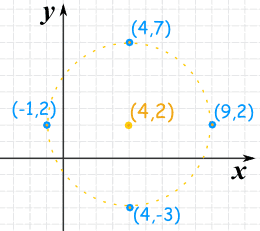 |
Now, just sketch in the circle the best that you can!
How to Plot a Circle on the Computer
You need to rearrange the formula so you get "y=".
You should end up with two equations (top and bottom of circle) that can then be plotted.
Example: Plot (x-4)2 + (y-2)2 = 25
So the center is at (4,2), and the radius is √25 = 5
Rearrange to get "y=":
| Start with: | | (x-4)2 + (y-2)2 = 25 |
| | | |
| Move (x-4)2 to the right: | | (y-2)2 = 25 - (x-4)2 |
| | | |
| Take the square root: | | (y-2) = ± √[25 - (x-4)2] |
| | | (notice the "plus/minus" ...
you can have two square roots!) |
| | | |
| Move the "-2" to the right: | | y = 2 ± √[25 - (x-4)2] |
Now, plot the two equations, and you should have a circle:
- y = 2 + √[25 - (x-4)2]
- y = 2 - √[25 - (x-4)2]
by nur shadzana circlecircle dotdot

















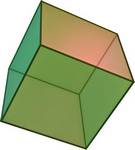 A cube is called a hexahedron because it is a polyhedron that has 6 (hexa-means 6) faces.
A cube is called a hexahedron because it is a polyhedron that has 6 (hexa-means 6) faces. 